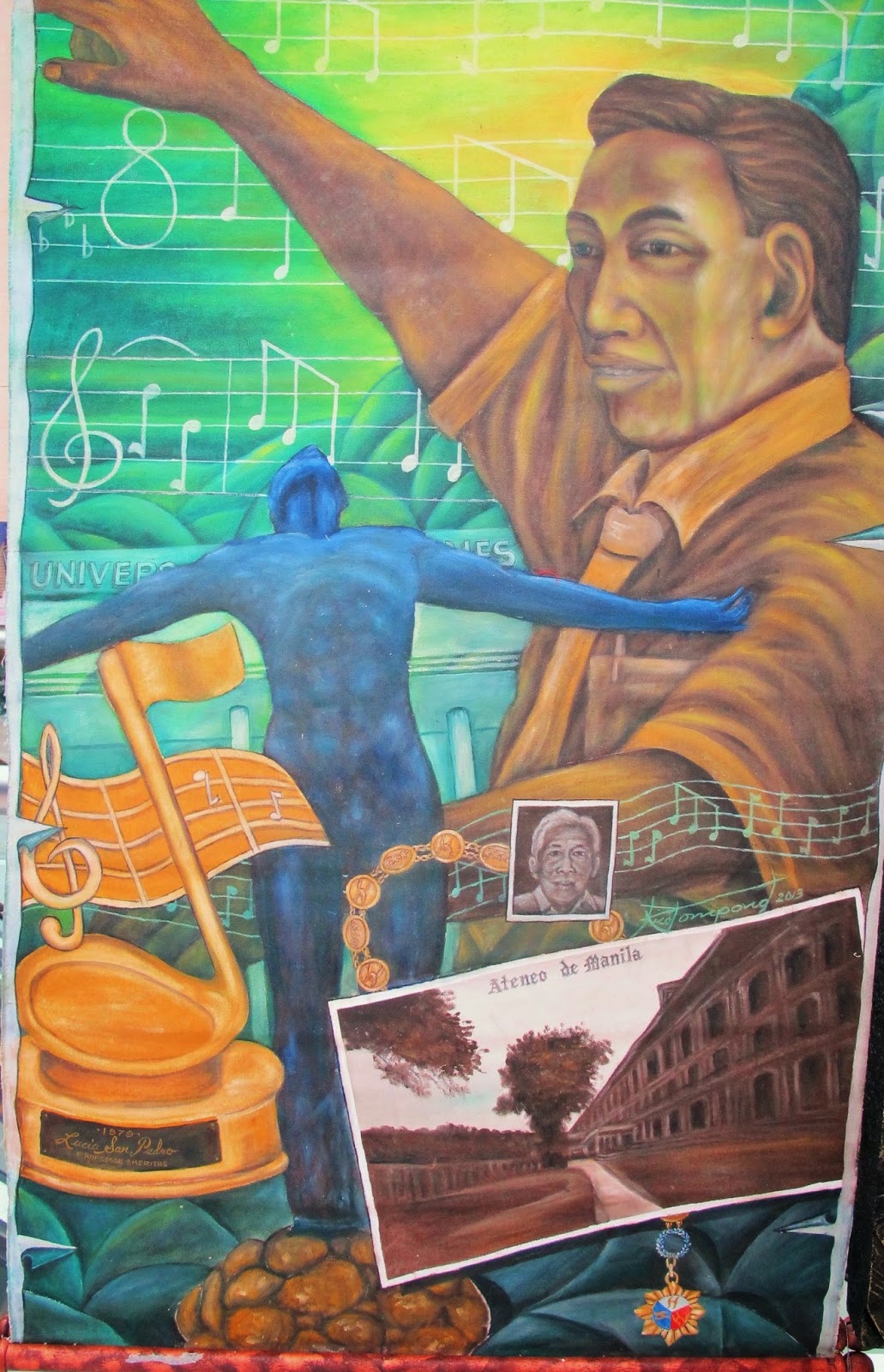 |
| A Lucio San Pedro tribute show was mounted at the Angono Lakeside Park. |
Perhaps the most
beautiful sunset in Angono, a town in the province of Rizal, immediately east
of Manila, is at the shore of Laguna Lake (actually Bay Lake), where the sun
gilds the thriving water hyacinths and the slender boats gliding on the water.
Danilo Diaz told in a poem how the
late Lucio San Pedro, National Artist for music and one of the town’s most illustrious sons, would
regularly visit the Angono shore, popular called Wawa in the barangay of San
Vicente, even in his wheelchair. The poet imagined what the esteemed composer
was thinking seeing the changes in the once bucolic lakeside area of his
childhood.
Angono mayor Gerardo Calderon recalled how Wawa
has become a dumping site with numerous informal settlers. In recent years, he
spearheaded rehabilitating the area and naming it Angono Lakeside Park with a
number of amenities in the planning for people to visit and enjoy the ambiance.
The holding of cultural events here is also hoped for, and this aspiration was
ushered by the program “Sa
Gunita ng Musika at Awit: Pang-alaalang Palatuntunang Parangal sa Ika-102 Taong
Kaarawan ni Maestro
Lucio D. San Pedro” (By the Memory of Music and Song: Memorial Tribute
Program on the 102nd Birth Anniversary of Maestro Lucio D. San Pedro) on
February 11, 2015.
The tribute show was also meant to showcase the park
and contribute to the celebration of the February National Arts Month, with
partial funding from the National Commission for Culture and the Arts.
“With this project, we hope to cherish the life
and contribution of professor San Pedro and inspire others to contribute in art
and culture making in Angono, the ‘Art Capital of the Philippines’ and haven of artists,” said Patnubay Tiamson, the town’s tourism officer.
Angono has been famous for having numerous artists.
Their galleries and ateliers are often visited by tourists. Its most known
visual artist is the late National Artist for visual arts Carlos “Botong” Francisco.
A number of writers and musicians call Angono home as well.
Preceded by a modest visual arts exhibit at the SM
Center Angono, “Sa Gunita ng Musika at Awit” attempted to represent the different forms of
art as well as showcase Angono culture. Several higantes decorated the venue,
which had a makeshift stage between the shore and rows of street food stalls.
The scent of isaw and pork barbecue
would often waft through the performance. Neighborhood kids wove in and out of
the audience. At one point, the higantes
would dance.
Diaz and other members of the Angono Tres-Siete Poetry
Society—Richard Gapi, Noel Vocalan and Glen Sales—opened the program reading poems on San Pedro (“Umuugoy
Pa Ang Duyan” and “Ang
Himno ni Lucio at Ako”) and about art (“Pananalig,” about keeping faith and making art despite many
odds). The program was interspersed with dances from the three major regions of
the country such as binuyugan of
Pangasinan and pandango sa ilaw of
Lubang Island, Mindoro, from Luzon; lapay
bantigue of Masbate and tinikling
of Leyte, from the Visayas; and a malong
dance from Mindanao. They were performed by the Ang Nuno Dance Troupe, made up
of selected students in dance of the Regional Lead School for the Arts in
Angono (RLSAA), accompanied by live music from the Las Cuerdas de Angono, the
student rondalla group also of RLSAA.
Most of the performers were students.
Several music and songs of San Pedro remained to be
the meat of the show such as “Sa
Mahal Kong Bayan” (1950) and “Kayumangging
Malaya” (1983), performed by Ars Noveau Chorale. The popular
lullaby “Sa Ugoy ng Duyan” (1947) was performed by a student of RLSAA
Jasmin Ericka Dolores with music from the RLSAA Chamber Orchestra and a
dramatic interpretation by Teatro Kalayaan.
The finale numbers, “Suite Pastorale” (1956), a sweeping composition evoking the
rusticity of Angono, and “Jubilate” were performed by the Angono National Symphonic
Orchestra, one the country’s very few community-based orchestras, founded
by San Pedro himself. A San Pedro
relative, Alberto delos Santos, recalled that there were eight bands existing
in the town, including the Angono National Symphonic Orchestra, which until now
keeps alive the music and artistic excellence embodied by the National Artist.
San Pedro was a master composer, conductor and teacher
who produced a wide range of musical works and hailed for incorporating folk
elements in his music.
 |
| The Ars Noveau Chorale |
 |
| The Ang Nuno Dance Troupe |
 |
| The Angono Symphony Orchestra |
 |
| The Angono
Tres-Siete Poetry Society |
 |
| The small exhibit at the SM Center Angono |
 |
| Artworks on San Pedro by local artists |













No comments:
Post a Comment